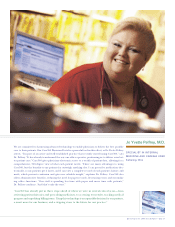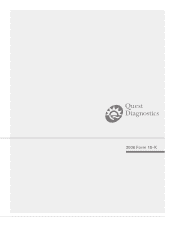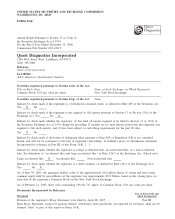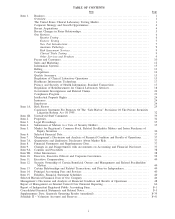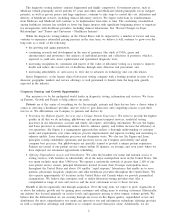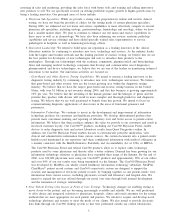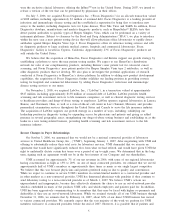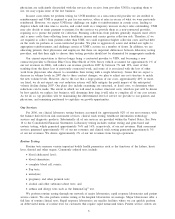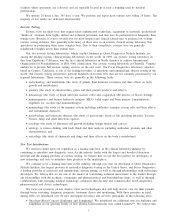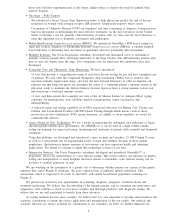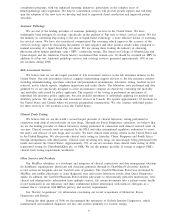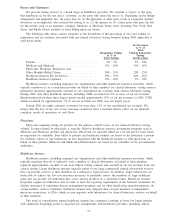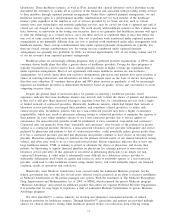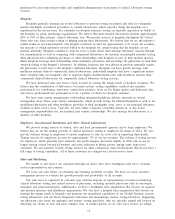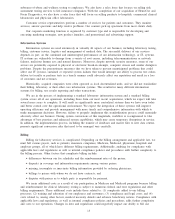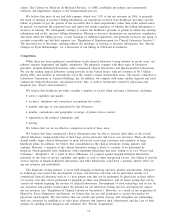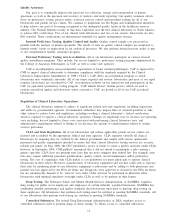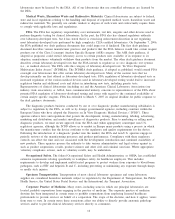Quest Diagnostics 2006 Annual Report Download - page 27
Download and view the complete annual report
Please find page 27 of the 2006 Quest Diagnostics annual report below. You can navigate through the pages in the report by either clicking on the pages listed below, or by using the keyword search tool below to find specific information within the annual report.physicians are sufficiently dissatisfied with the services they receive from providers UNH is requiring them to
use, we may regain some of the lost business.
In most cases when we perform testing for UNH members as a non-contracted provider we are entitled to
reimbursement and UNH is required to pay for our services, often at rates in excess of what we were previously
reimbursed. However, we expect UNH may challenge our rights to reimbursement in certain cases, leading to
disputes which will take time to resolve, and could result in a temporary increase in days sales outstanding. UNH
may also decide to remit payment to patients for the services we provide them as a non-contracted provider,
requiring us to pursue the patient for collection. Pursuing collections from patients generally requires more effort
and is more costly than collecting from a healthcare insurer and carries greater collection risk. Therefore, if we
are required to collect from patients rather than UNH, we could experience higher collection costs and bad debt
on the work we perform as a non-contracted provider. We plan to aggressively assert and defend our rights to
appropriate reimbursement, and challenge certain of UNH’s actions on a number of fronts. In addition, we are
educating patients, their physicians and employers that there are important differences between laboratory testing
providers, and that their right to choose their testing provider should not be eliminated by inappropriate methods.
Our current expectation is that no longer being a contracted provider to UHN, and becoming a non-
contracted provider to Horizon Blue Cross Blue Shield of New Jersey (which accounted for approximately 1% of
our net revenues in 2006), will reduce our revenue growth in 2007 by between 7% and 10%, most of that
resulting from the direct loss of previously contracted work, and some of it associated with the loss of other
work from physicians who choose to consolidate their testing with a single laboratory. Given that we expect a
decrease in volume levels in 2007 due to these contract changes, we plan to adjust our cost structure to match
the new volume levels. However, due to the fact that a large portion of our costs, approximately 40% or more,
are fixed, we do not expect our cost reduction actions will fully mitigate the profit impact of the anticipated
volume decline during 2007. Our plans also include examining our structural, or fixed costs, to determine what
reductions can be made. The extent to which we will need to reduce structural costs, which in part will be driven
by how quickly we replace lost business, will determine how long it will take to complete all of our cost actions.
As we do so, top priorities will be maintaining the differentiated level of service we provide to our patients and
physicians, and remaining positioned to capitalize on growth opportunities.
Our Services
For 2006, our clinical laboratory testing business accounted for approximately 92% of our net revenues, with
the balance derived from risk assessment services, clinical trials testing, healthcare information technology
services and diagnostic products. Substantially all of our services are provided within the United States. See Note
16 to the Consolidated Financial Statements. Laboratory testing includes routine testing and gene-based and
esoteric testing, which generated approximately 76% and 16%, respectively, of our net revenues. Risk assessment
services generated approximately 5% of our net revenues and clinical trials testing generated approximately 3%
of our net revenues. We derive approximately 2% of our net revenues from foreign operations.
Routine Testing
Routine tests measure various important bodily health parameters such as the functions of the kidney, heart,
liver, thyroid and other organs. Commonly ordered tests include:
•blood cholesterol level;
•blood chemistries;
•complete blood cell counts;
•Pap tests;
•urinalyses;
•pregnancy and other prenatal tests;
•alcohol and other substance-abuse tests; and
•asthma and allergy tests such as the ImmunoCap®test.
We perform routine testing through our network of major laboratories, rapid response laboratories and patient
service centers. We also perform routine testing at the hospital laboratories we manage. Major laboratories offer a
full line of routine clinical tests. Rapid response laboratories are smaller facilities where we can quickly perform
an abbreviated menu of routine tests for customers that require rapid turnaround times. Patient service centers are
6


